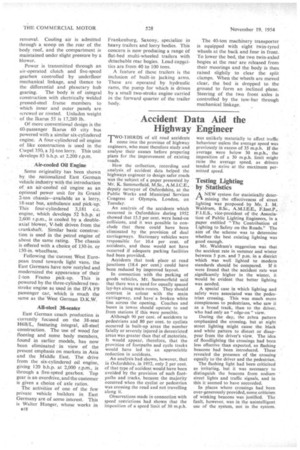Accident Data Aid the Highway Engineer
Page 52

If you've noticed an error in this article please click here to report it so we can fix it.
TWO-TH1RDS of all road accidents come into the province of highway engineers, who must therefore study and analyse their causes before preparing plans for the improvement of existing roads.
How the collection, recording and analysis of accident data helped the " highways engineer to design safer roads was the subject of a paper presented by Mr. K. Summerfield, M.Sc., A.M.1.C.E., deputy surveyor of Oxfordshire, at the Public Works and Municipal Services Congress at Olympia, London, on Tuesday.
An analysis of the accidents which occurred in Oxfordshire during 1952 showed that 15.5 per cent. were head-on collisions, and it was possible to conclude that these could have been eliminated by the provision of dual carriageways. Stationary vehicles were responsible for 10.4 per cent. of accidents, and these would not have occurred if adequate parking facilities had been provided.
Accidents that took place at road junctions (18.4 per cent.) could have been reduced by improved layout.
In connection with the parking of goods vehicles, Mr. Summerfield said that there was a need for equally spaced lay-bys along main routes. They should contrast in colour with the main carriageway, and have a broken white line across the opening. Coaches and buses in towns should operate to and from stations if this were possible.
Although 90 per cent, of accidents to pedestrians and 80 per cent. to cyclists occurred in built-up areas the number fatally or severely injured in derestricted areas was greater than that of motorists. It would appear, therefore, that the provision of footpaths and cycle tracks would have led to an appreciable reduction in accidents.
'An analysis had shown, however, that in Oxfordshire, in 1952, only 2 per cent. of that type of accident would have been avoided by the provision of such footpaths and tracks, because the majority occurred when the cyclist or pedestrian was crossing the road and not travelling along if.
Observations made in connection with speed restrictions had shown that the imposition of a speed limit of 30 m.p.h. was unlikely materially to affect traffic behaviour unless the average speed was previously in excess of 35 m.p.h. If the average were below 30 m.p.h., the imposition of a 30 m.p.h. limit might raise the average speed, as drivers tended to strive at the maximum permitted speed.
Testing Lighting by Statistics
ANEW system for statistically determining the effectiveness of street lighting was proposed by Mr. J. M. Waldram, B.Sc., A.M.I.E.E., F.Inst.P., F.I.E.S., vice-president of the Association of Public Lighting Engineers, in a paper entitled "The Contribution of Lighting to Safety on the Roads." The aim of the scheme was to determine whether the best existing lighting was good enough.
Mr. Waldram's suggestion was that the accident rate in summer and winter between 5 p.m. and 7 p.m. in a district which was well lighted to modern standards should be compared. If it were found that the accident rate was significantly higher in the winter, it would be evident that better lighting was needed.
A special case in which lighting and safety were associated was the pedestrian crossing. This was much more conspicuous to pedestrians, who saw it as a broad track, than to the driver, who had only an " edge-on " view.
During the day, the zebra pattern emphasized the crossing, but at night street lighting might cause the black and white pattern to distort or disappear from the driver's view. The idea of floodlighting the crossings had been less effective than expected, so flashing beacons had been introduced. These revealed the presence of the crossing equally to the driver and the pedestrian.
The flashing light had been criticized as irritating, but it was necessary to distinguish the beacons from sodium street lights and traffic signals, and in this it seemed to have succeeded.
In places where crossings had been over-generously provided, some criticism of winking beacons was justified. The fault, however, was in the unintelligent use of the system, not in the system.




































































































